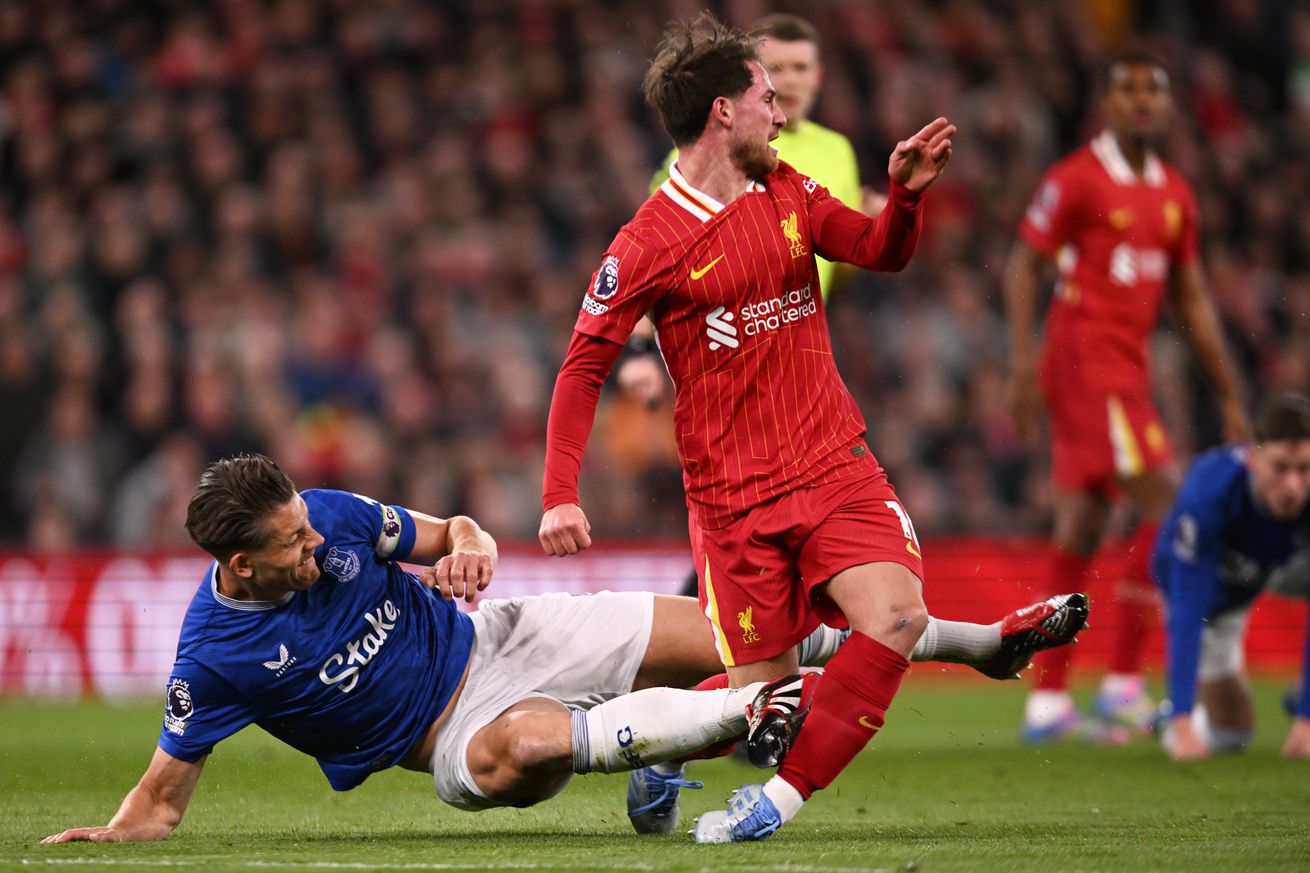
Liverpool managed an ugly win regardless
It is to Liverpool’s credit that they kept their heads despite refereeing errors in Wednesday’s Anfield Derby: most of us will be able to recall Liverpool sides letting their emotions get the better of them after perceived officiating injustice, to say nothing of other sides in similar situations this season alone.
Liverpool won to go 12 points clear, and though their intensity in attack did seem to dip after the most notable incident, the Reds kept it together and came out on top.
But they should have been playing against 10 men, something that has since been confirmed by POGMOL, the professional body responsible for match officiating in the Premier League:
James Tarkowski was shown a yellow card in the 11th minute of the derby after a high and seemingly out of control challenge saw him land studs high on Alexis Mac Allister’s calf, a decision that was swiftly confirmed by VAR. POGMOL has since “accepted” that this was an incorrect decision, and it should have been a straight red.
Liverpool head coach Arne Slot welcomed the admission of double error on the part of both the central official Sam Barrot and Paul Tierney on VAR, who deemed the decision not to be a clear and obvious error. Speaking to press, Slot emphasized that, “It’s always good if they (the PGMOL) think a mistake has been made that they acknowledge it. It was so clear.”
Of course, we knew this already given that even David Moyes hedged in the immediate aftermath that his player “could have been lucky” to get away with the yellow as “it looked a high one.” Tarkowski himself spoke to Mac Allister after the match in a conversation that seemed sportsmanlike.
Other notable Evertonians were stronger than Moyes, who might feel some loyalty to his team is called for in front of the press. Duncan Ferguson, a man not shy of a tackle himself, firmly chastised the decision while the match was still being played: “There is no argument. It’s a straight red. It’s a legbreaker. He should have given the red on the pitch.”
When Big Dunc says as much, you really have to believe it. Mike Dean, who might be likely to take the side of officials on gray area calls, said he was “astounded” that Tarkowski stayed on the pitch.
Given how clear-cut most of the reaction has been, one might wonder whether NBC’s Lee Dixon might be blushing at his strong defense of both the tackle and the decision in the long minutes after the incident took place. In the end, Tim Howard’s position that Tarkowski “knew what he was doing” but that he didn’t feel it was a red card is thankfully a minority opinion, even amongst the Toffee-affiliated pundits.
For the most part, the reaction has been to everyone’s credit. It is easy in the contemporary context to react to arguments around decisions along tribal lines — and for a number of complex reasons it’s often easier for some to do this when the injured party is Liverpool Football Club.
Of course, this consensus says something about how clear the foul was. A red card is given for serious foul play in the following situations, per IFAB:
A tackle or challenge that endangers the safety of an opponent or uses excessive force or brutality must be sanctioned as serious foul play.
Any player who lunges at an opponent in challenging for the ball from the front, from the side or from behind using one or both legs, with excessive force or endangers the safety of an opponent is guilty of serious foul play.
A serious argument could be made that Tarkowski’s foul could tick a box for everything listed in these two descriptions. It should not have been a particularly difficult or nuanced decision from VAR to send the central official to the pitchside monitor for review.
That the response has been so clear is important, even if this is not the first and won’t be the last ludicrous error.
Officiating cannot improve if errors are only called out by the side harmed by them, and the reaction to this particular decision has been instructive: there’s been no overreaction and abuse of the referee or VAR as individuals, and a clear acknowledgement of error from all corners emerged. This sort of adult discussion after the fact is how we improve the quality going forward.
Naturally this only applies to the big, headline errors. It’s unclear that there’s anything to be done about the way officials seem happy to referee Liverpool at home — as Neil Atkinson has noted numerous times on The Anfield Wrap,* it’s as if officials come to Anfield determined not to be intimidated, and thus end up refereeing the Reds as if they’re the away side.
It’s to Liverpool’s credit that they no longer lose their heads when marginal decisions, again and again, go to their opposition. They no longer lose their heads when opponents are allowed to kick, push, and headlock them to no whistle, while they are unable to respond in kind. They no longer lose their heads and go out for blood when an opponent’s leg breaker is shown a mere yellow.
This mental strength is a major asset. It gives them a firm advantage over some of their rivals, which is no small thing, and is worth saying. Others have seen points dropped this season in part through their own decision making in the face of officials’ approach.
It is, however, a shame they’ve been forced to develop this particular mentality.
*If you are a subscriber and missed it, I strongly recommend the chat between Neil Atkinson and Rory Smith entitled “The Collapse of Refereeing Standards in Europe?” on TAW.
